This is a story that you may have come across either in the Yahoo GolfBallTypewriter forum or if you happened to check out the Typewriter Database entry on this particular machine, but the Professor and I felt the story needed fleshing out – the sort of report that works well in the TypeCast format. I offered to publish it if the Professor would write it up, so without further flimflam, here’s “Restoring an IBM Composer” by ProfessorC, with IBM Composer typesetting and photos by Clark H.:
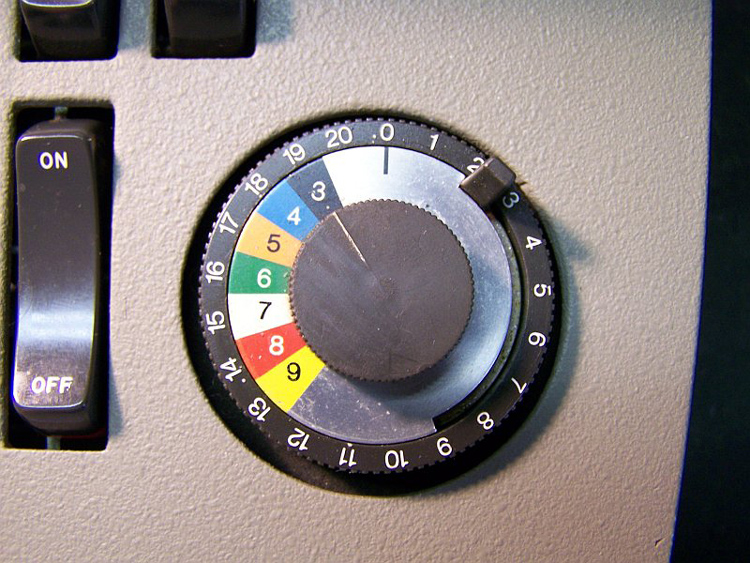
Justification Dial. The center knob changes the width of spaces, the outer knob is set to the number of spaces required.
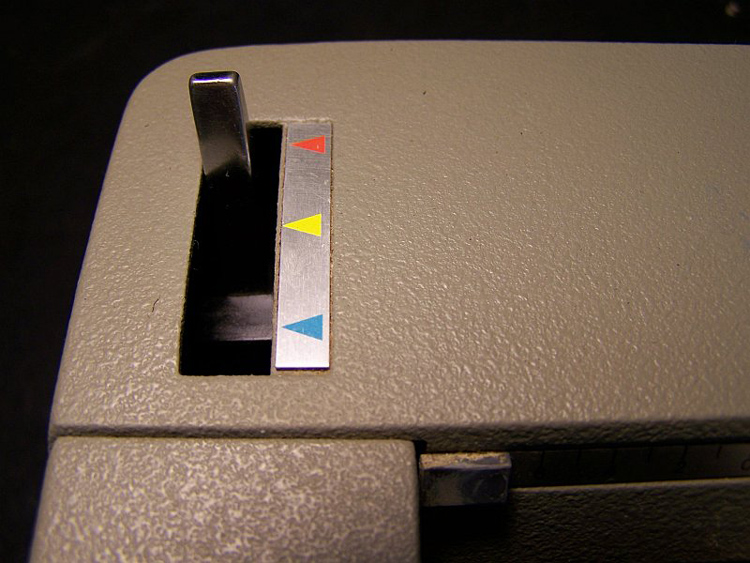
Pitch selector. Three different pitches are selectable. The color of the arrow corresponds to the arrow color on the type element.
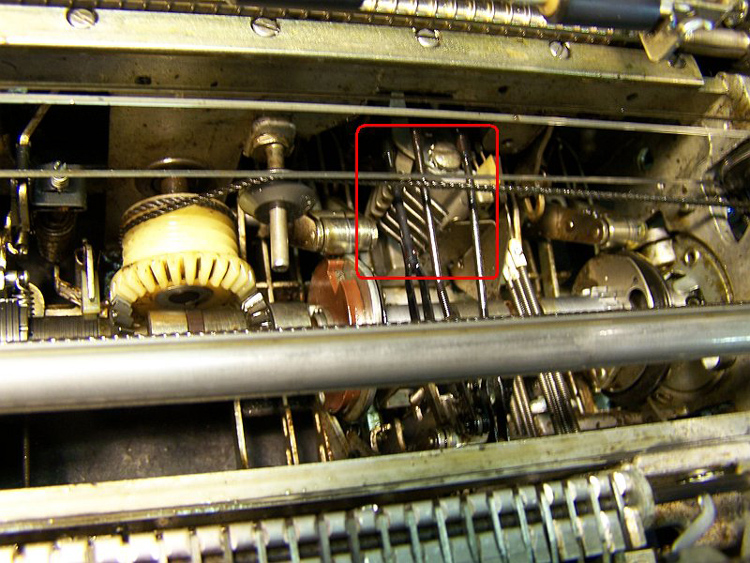
This is the chopper block that allows between 3 and 9 unit spacing for each character or space. It is actuated with 6 small cables from bails on the keyboard.
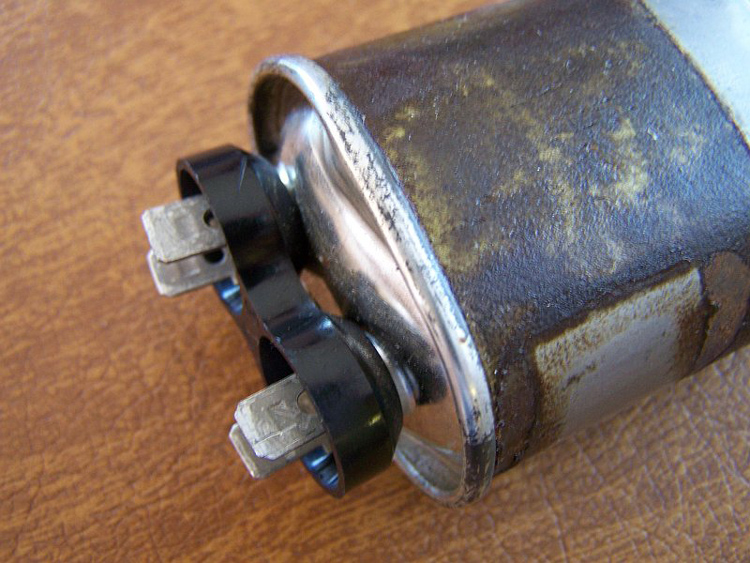
Swollen, bad capacitor. The motor was running slow and got really hot until I replaced it. The brown film on the capacitor is baked-on oil!

Leadscrew Bias gear after repair. The drilled-out areas were filled with JBWeld. The wire does not interfere with the operation.
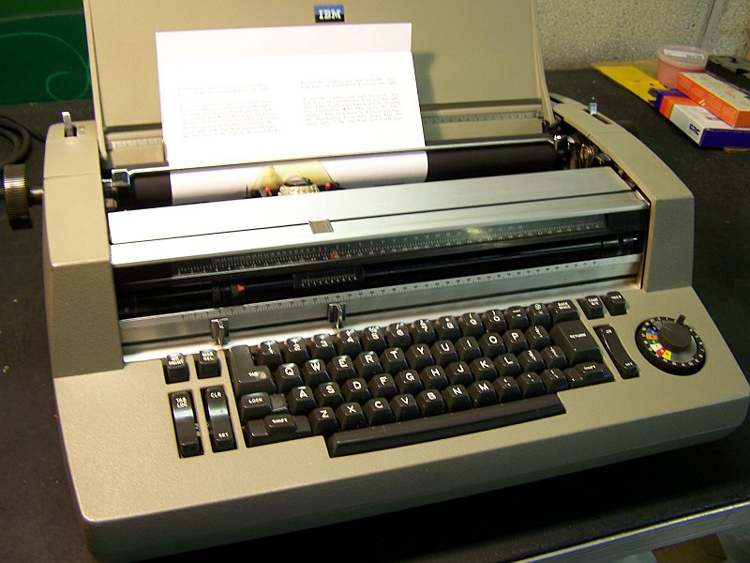

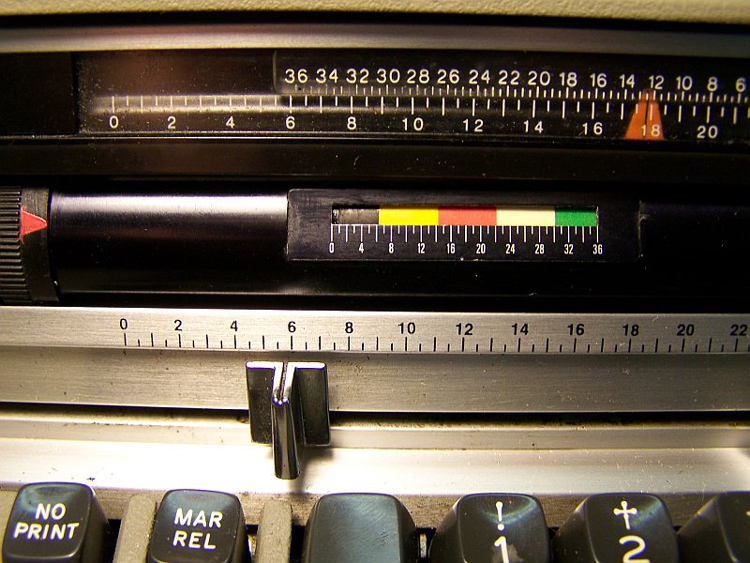

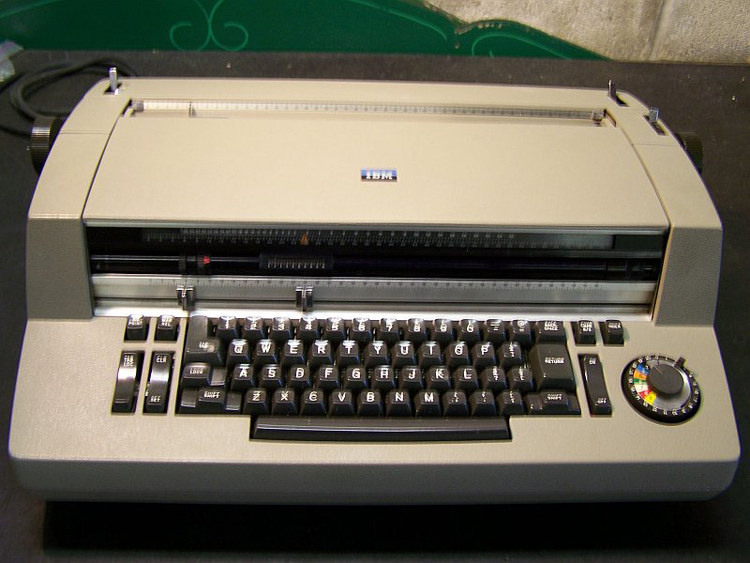


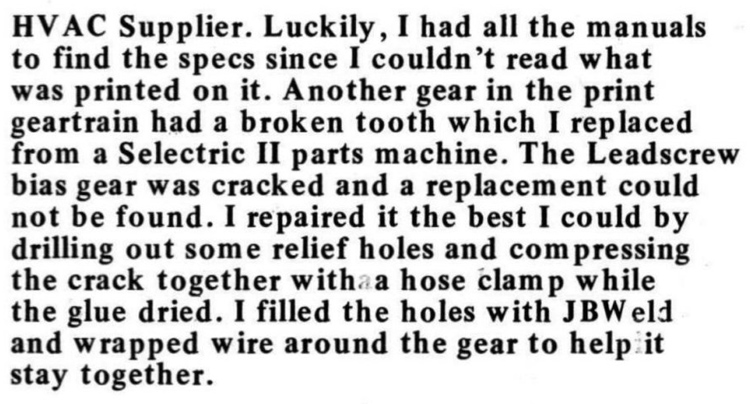
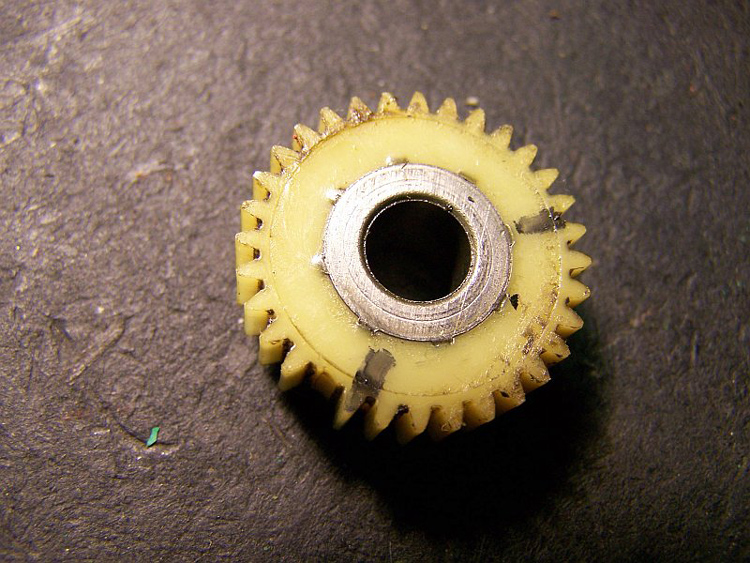

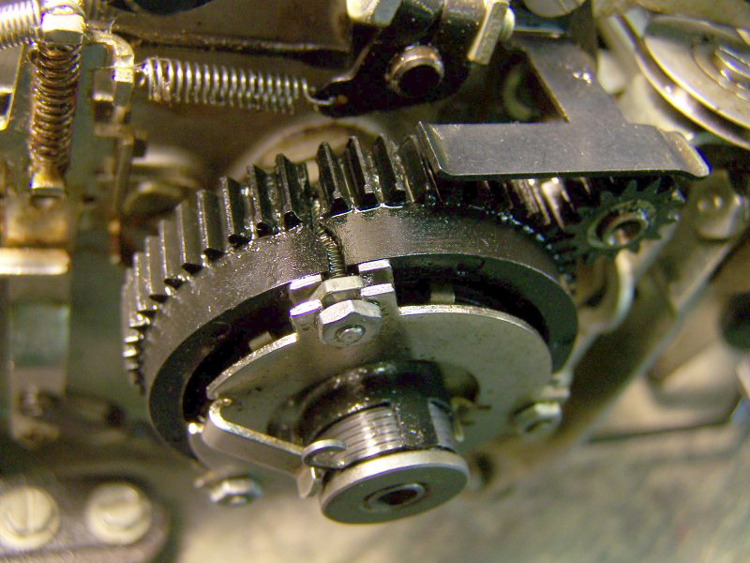



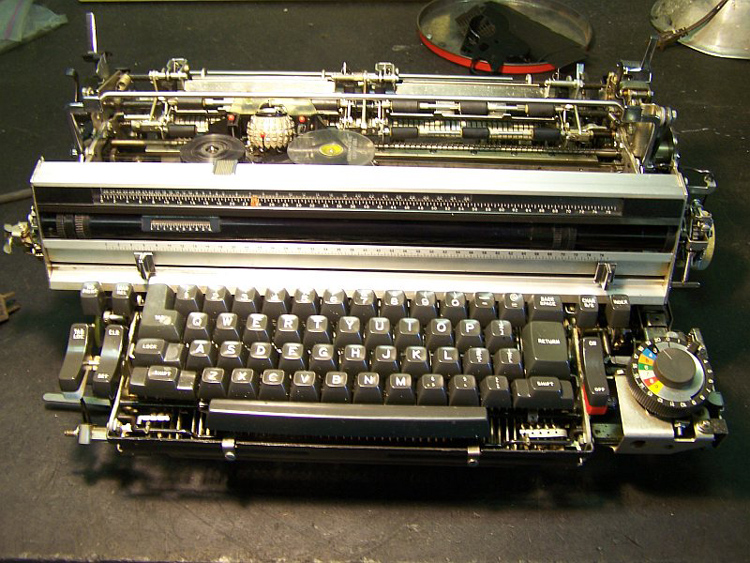
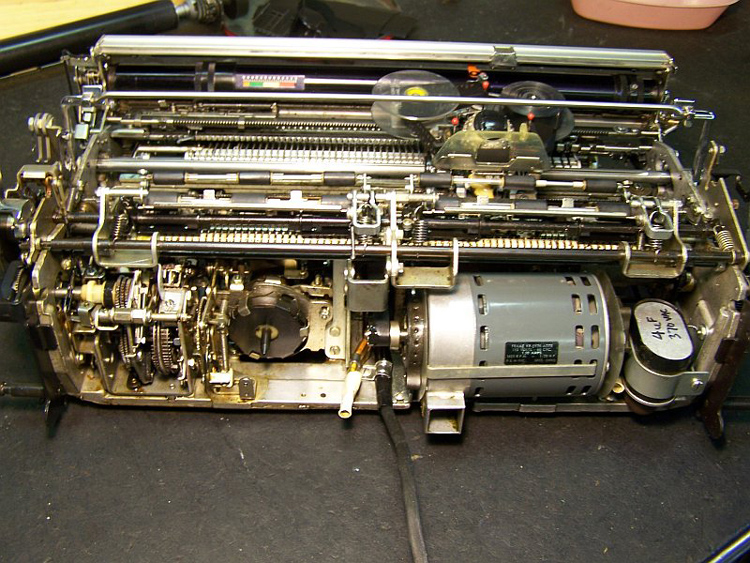
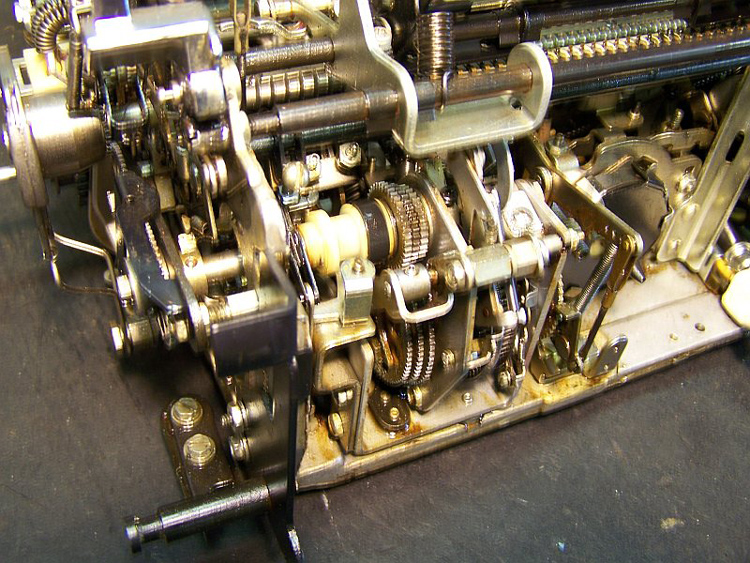
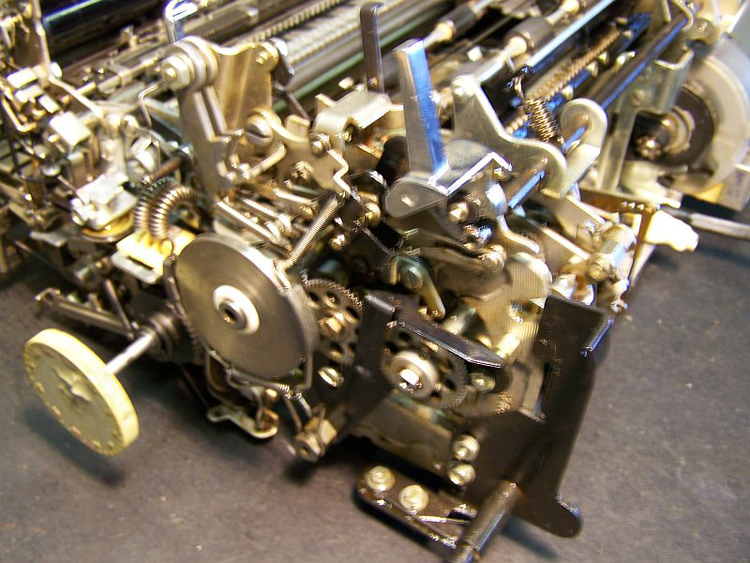
(Blink. Blick) What am I looking at! I’ve never seen one of these before.
Wow… You’ve done an amazing job at getting this machine back together.
That is quit a complicated mechanical marvel! I never heard of one of these before. That was a great job getting that machine back to working condition.
Very lucky that the machine was not eaten up by mold and all the plastic dried to a beyond repair brittleness since the machine was stored in a shed and came out of Florida. I cringe if I need to keep any typewriter in the garage for even a few months in Florida. The enviornment here will kill the unkillable.
Color me very, very impressed by this repair job!
I’ll also put in a plug for the Varityper DSJ, which was capable of differential spacing and justification a few decades before the IBM Selectric Composer. I’ve heard that the Varityper is much more reliable, too.
A fabulous example of human and mechanical ingenuity!
It’s noteworthy that IBM chose to install a metal clutch cycle pulley in this machine rather than a plastic one found in regular Selectrics. The manual says that is because the Composer requires 40% more torque to operate all the extra components and that required a wider belt and larger motor too. The alignment in the typecast print appears to be irregular, but it’s been highly enlarged. The actual print was 10 point.
It seems to me that IBM needed a typesetting machine and adapted the Selectric technology to accomplish it, instead of starting from scratch with a new design. I think this led to compromises and over-complexity. The Vari-Typer was purpose built and by all accounts, more rugged.
Hello
I have two IBM composers with manuals would you be interested? I hate to see them go to the landfill site we used them for our business before computers. They were both originally over 55,000 each as I remember. Living in Canada
Sincerely
Deborah
Hello Deborah,
I’ve sent your offer to ProfessorC who did this restoration, and he’s expressed interest, but the major issue would be shipping costs to get a pair of Composers from Canada to the southern US. The professor has just taken delivery of about 100 machines this week from a retiring shop owner, so it’d be tough for him to rescue more.
He suggested:
“On the Composers, you may want to send a note to Gerry Kaplan (ibmcompser.org) or Tony Casillo (typewritercollector.com) as they both are interested in Composers. Deborah didn’t mention if they work and that would be good to know.”
I’d also suggest posting your offer on the Yahoo “GolfBallTypewriterShop” forums:
https://groups.yahoo.com/neo/groups/golfballtypewritershop/info
There are likely to be collectors more local to you there who may be interested. (:
Deborah, I would be interested if you still have the machine(s) and they are in working condition. Thanks.
My neighbor owned a printing company for years. He is getting rid of his IBM Selectric Composer with one font ball. He bought it brand new in the ’60’s. I believe it to be in working condition. I can also find a few balls for it from another friend. If anyone is interested in having it, please contact me quickly. He needs it gone soonest.
P.S. Thanks to Rev. Munk for posting this on his blog. There are likely very few of these machines still in existence and even fewer that actually still operate. I only know of one more. This machine is now in the hands of resident scholar at the Media Archeology Lab at the University of Colorado – Boulder.
ProfessorC
I came across this site while looking to see what an IBM Selectric Composer 6251 would be worth. We had bought one around 1987. We had intended to use it but did very little with it. It is in great shape and looks as nice as the one pictured on this site. We put it on and it does run but we cannot find the ball for it. It got separated from the composer somehow when we moved things around. We would like to sell it but don’t know what it is worth and is there a need for it. Looking forward to your input. Thanks and have a nice day.
This article is 10 years old so I don’t know if anyone will see it, but I found an IBM Selectric Composer in my attic that I need gone asap and cannot move it by myself and cannot ship. It includes 4 manuals and 11 of the type balls (no clue whether there’s a ball in the machine). I’m in Milwaukee. No way to test if it works. I have it listed on FB MP but no way to post a link here.
Hello I’m local to Wisconsin, fox cities area. I would be interested if this is still available.
Wow…awesome committment to what was no doubt a tedious project! Cool looking machine. I love machines from this time period, manual and electric.
OK, so maybe all this golf-balling isn’t such a bad idea after all. As a wet-behind-the-ears graphic designer, I inherited a series of manuals typeset on one of these and pasted-up (on the author’s kitchen table), along with line art on 115% printed grids. Of course when revision time came around the comp was nowhere to be found and the artwork was fragile to say the least. I’m pretty sure one title was then re-keyed on a Linotron but by an outfit that used to do all British Leyland’s typesetting but before long came the compelling argument for getting a Mac. It ended up being much cheaper to pay a copy typist to rekey everything and then compose it all myself. I can see the attraction of small companies for getting a composing typewriter – they must have paid for themselves fairly quickly.
My high school had one of these in the journalism classroom, it was the mystery typewriter that nobody knew how to use. It was used to typeset columns for the school newspaper, which was offset print at a real newspaper printing press. The story would be typed out (can’t remember if we actually justified), trimmed or cut to fit the columns and space, put through a waxer, and laid out on newspaper template paper for photo. I wonder where it is now…
Impressive work! I have an IBM Selectric Composer stored in much better conditions than the one you have described. It does not presently work, but I believe the problem is minor and the overall condition is good. I’ve always felt it was the best keyboard I’ve ever used. But it’s time to part with it. Do you have an interest in it? I’m in Washington state, north of Seattle.
Donna
Hi Donna,
I’m wondering if you still have this machine? I know it’s been over a year since your post. I’m very interested and live just below you—kind of—in Portland!
Kind regards,
Briar
Hello Briar, I believe the one Donna had was adopted by Nick B, then sent to me and I sent it along to Kyle in NYC a number of weeks ago. It’s a parts machine now and has no motor.
I have a IBM Selectric Composer with a couple of the three drawer green element storage containers full of elements. I also have the owners manual. I would like to sell this machine if anyone is interested in buying it. It is in very good condition. I am located about an hour north of Indianapolis. I can email pictures.
i have a IBM composing typewriter. My Dad bought it back in the 70s . He used it to publish his books on coins. If he could only see how far computers have taken us , I would love to see his face. I do not know why I still have this machine ,could be sentimental .
Well, it’s a pretty fascinating machine – I just picked one up and restored it this week myself (with the able help of ProfessorC, who restored this one). See latest posts.
Let me know if you ever decide to unload it. I’ve got a fixer-upper one coming sometime this month to work on, but I kind of forsee myself devoting a significant amount of space in my collection for a few of these beasts. (:
This brings back memories. I was a CE with the Office Products Division and serviced the stand alone composer along with the MT/SC and all later versions as well. I may be mistaken, but I believe this machine is the most complex MASS PRODUCED mechanical product ever made and still holds that distinction.
You’re not wrong. I’ve just fixed up one that still has the MT/SC interface kit and I have another one coming to fix up, and they are surely the most complex machines I’ve ever encountered. Hey I don’t suppose you happen to know anything about dating a Composer by it’s serial number, do you?
From looking at a page of typed output that is left- and right-hand justified, is it possible to determine whether it was typed on an IBM Selectric Composer?
yes, there are numerous differences between just about any typeset text made mechanically versus digitally, primarily because since the advent of digital typesetting, justification is digitally figured on exactly 72 points per inch. This is not exactly true of mechanical typesetting, so a line of exactly the same type compared will show the spacing to be significantly different and many characters will be subtly different sizes.
You wouldn’t even need a Composer to test it. Just set the same text in a digital program and print it out and compare. If it exactly matches, the original was digitally typeset. If the spacing within the text is significantly different, it was mechanically typeset. Could be a Composer or a Coxhead, or even any of a handful of optical film typesetters that flourished briefly between the 60’s to the 90’s.
May I send you a sample page?
Ok, so it’s one of those sorts of requests then. *sigh*
If this is about the Bush documents, rest assured that CBS got swindled and the document is an absurd fake. To think it isn’t is to assume a secretary (or more absurdly, an army officer) had access to a $10,000 professional typesetting machine and was willing to flawlessly typeset a standard dash-off memo using a machine with no correction capability while swapping multiple typeballs and hand-figuring backspacing units while doing it. It’s stupid on it’s face, and has been repeatedly and conclusively proven as a fake using the exact method I described in the comment above.
I am not a professional document examiner, no matter how hard the Birthers and the Bushies try to get me to be, and they’ve tried pretty hard. I’ve provided you with the basic information anyone with eyes and a light table needs to determine digital from mechanical typesetting, and am not even remotely interested in embroiling myself in whatever weird and hopeless political cause is attached to whatever document it is you might wish me to examine. So… no, thank you very much. (:
OK. (It’s just a private document — nothing to do with any of the issues you mention, and involving no politics of any sort!)
ahh, ok. Heh, sorry, the Birthers have been after me the past month to somehow prove that Obama’s birth certificate was forged, so I’ve got an itchy trigger finger when it comes to the whole “document analysis” thing.
Still, you’ve likely got all you need to determine what you need to know of your specific document. Just approach it from the point of view of “can I prove that it’s digitally created” rather than “can I prove it was mechanically created”. Basically, re-type the document in Word with the same font and margins as the original and apply justification and print it out. Given the same font/size/margins, a mechanically typeset version would be shorter than a digital one by an obvious amount, and the word breaks would be in different places.
I used to have the website ibmcomposer.org. I’m curious whether you have experience with the Mag Card Selectric Composer. I had one of them, but it needed the read/write heads readjusted – I believe there is a special “adjustment” card that CE’s had. Do you have any of that for adjusting mag card reader/writers?
ahh, there you are – we were wondering where ibmcomposer.org went, as it was at one time the best resource for learning about these machines. (:
I’ll shoot you an email, I don’t know much about the mag card setups, but I’ve forwarded your question to a group of old IBM CE’s to see if anyone can help. My own Composer has the sensor kit and j-wire setup under the keyboard to be attached to the MT/SC interface, but it had been divorced of the interface probably in the late 70’s and re-sold to the owner I got it from.
Hi, I’m not sure if this is kosher but I was curious if this machine was for sale or another like it
well, this one wasn’t mine, and besides, the Professor sold it to this language poet. I have two others which have the MT/SC interface, one works great, the other is a parts machine. But no, none are for sale unless you plan on waving an awful lot of Benjies at me – functioning Composers are scarce as hen’s teeth. (:
Yes I would be willing to pay good money please email me at kylehalstead23@gmail.com so we can discuss it further. Thank you. I really desire this machine for publishing. Just please email and we can discuss a price
Hi Kyle,
I came across this site while searching to see what a IBM Selectric Composer 6251 is worth. We had purchased one in 1987 but hardly used it. It is in great shape and looks as nice as the one on this site. We put it on and it runs but we misplaced the ball. Somehow it got separated when we moved things around. We are looking for it and hopefully will find it. Would appreciate any input with cost and if still in demand. Thanks and have a nice day.
I have one now, the black later one(“electronic conposer”) with about 20-30 working font balls, but it needs a new belt and I can’t fix it. But I really would like to buy a working one if you would sell it. I would be willing to figure out a price with you. please email thank you
They are fascinating machines. I have acquired one that is fully gummed with the glue like grease. Did you remove the electronics and then dunk the entire chassis in some solvent? If so, what did you use?
I’m having a hell of a time finding a manual that shows how these are assembled.
well I definitely wouldn’t try to dunk a Composer, too many plastic parts inside. Note that there are two kinds of Composers, the first all-mechanical “Grey” model that was introduced in 1966 (shown above) and the later “Electronic Selectric Composer” that came out in 1975, which is Charcoal-colored and is stuffed with electronics. Sounds like you have the “Electronic” version. I may know someone with a parts machine if you need one.
When I cleaned mine, I used spray cans of carb cleaner and LPS1 with nozzles, making sure to clean very precisely and wiping up excess before it went anywhere near plastic bits. Patience is a virtue.
A few of us Composer owners do typeball swaps. You got any extra balls? If so, we might be able to fill in some holes in your collection. (:
from Bristol, UK. I have just cleared out the bulk of my graphics/printing/bookbinding business and very reluctantly dumped two Composers (one original and one electronic) as I could find no-one interested in taking them. However, I still have a few type-balls and manuals if any enthusiast needs them for a project.
I would be very interested! I’m emailing now (:
Hi Folks,
Just came across this interesting site. I was an IBM CE in the 70’s 80’d and worked exclusively on Graphics in the NYXC area. Mostly Composers and MT/ST’s to start and then on toe ESC’s and Mag Composers. They were mechanical marvels. A lot of folks used MT/ST’s as input devices with the K=pak option to embed codes in the text then ran the tapes on a Composer system. The MT/ST were another mechanical beast and they used mostly relay locic to controls them. (until he model 5 cam out with circuit boards.)
This was the machine that I started my typesetting/graphic arts studio with. Was trained on its use prior to opening my studio at a local newspaper. I just loved using the machine (slow as it was) until I was able to purchase the tape-driven machine with console. After that I was able to upgrade to a Compugraphic phototypesetter (but still kept my Composer as back-up)until I eventually sold my studio in 1984. Thanks for the nostalgic article. I’m looking to purchase a Composer in working condition for old times sake.
Hi Munk,
I’ve inherited a Composer 6251 from my father who owned a print shop for decades. This was his personal machine. How would I go about testing this beast to see how well it’s operating? I currently live in Fresno, CA.
Thanks. JaneH
Well, plug it in and see if it types. (:
It’s all-mechanical in operation, so basically, if it types a good line or two, it’s working. Did you get many typeballs with it? I’d be interested in swaps or buying spare typeballs, as I’m trying to collect the whole set of available fonts. Good luck!
How do I unfreeze the whole keyboard on a MT/ST???
Thank you for your help.
I learned to typeset on this machine.
I’m looking for a composer. I used one as a journalist in the early 1980s and have wanted one ever since.I’m in London UK
Hi Simon. Are you still looking for a Composer? email me.
Hi Jane,
I am interested in your Selectric Composer. Can you email me at po.bunyapamai@gmail.com?
Thanks!
Only just found this site; glad it’s still up. Sure takes me back to some of my earliest publishing experience in the late 1960s with a student paper that had a Composer. Double typing for justified columns was so time-consuming that when I became editor I soon gained a fondness for ragged-right setting! I always knew they were complex machines but reading this really gave me a new appreciation of what was involved.
Some 10 years later in another place we had an electronic composer that made justification (relatively) simple, and seemed incredibly advanced.
Anyone know where to source a drive belt for the Composer?
I wish. I need one for mine. So far, no sources of NOS belts. I’m looking..
I have a Electronic Selectric Composer to give away. About 40 fonts and an operating manual. Composer needs a minor repair otherwise all are in excellent condition. Composer model #6375. Call me 540-797-3980.
Mine has the same leadscrew gear crack. I think I’ll try your method before it gets worse. Also, any leads on a belt yet? Mine looks like it might snap at any moment.
Yes, it took almost a year to find a belt – a fine fellow in Ireland found one for me in a junked Composer. There are no NOS ones anymore.
Well, maybe I’ll have to try to improvise. I take it a normal Selectric belt isn’t close enough? Your new belt does have any identifying numbers or such, does it? It kind of amazes me how few NOS parts are out there for old office equipment in general. I guess things just got scrapped when new models came along.
yeah, Selectric belt isn’t even close. Composer belt is longer, wider and thicker (Composer motor generated a *lot* more torque to move all the extra mechanics in the machine). There was a lot of trying belts that were *close* but not *close enough* before I was contacted by someone who had an intact original belt.
I had used the composer back in the 1960s – 1970s as a graphic artist. I eventually purchased the tape reader and console unit made by IBM for the composer which allowed all typewritten text to be stored on magnetic tape and played back.
I would like to know if anyone knows of a repairman that still services the composer. Thanks.
if you’re on Facebook, join the Golfball Typewriter Shop group here:
https://www.facebook.com/groups/gbtwshop/
That’s where all the guys with Composers looking for mechanics to restore them are gathered, trying to cajole reluctant ex-IBM techs into taking on the job. The main issue is usually lack of parts, so I hope you have a semi-intact spare to strip parts off of.
Or you can try a route where your personal information isn’t sold. Try the Typewriters group on groups.io
http://groups.io/g/TYPEWRITERS/topics
Hi, I’m ex IBM CE that worked on Composer, MT/STs etc in the 70s and 80s. I’m not doing much these days and working on those is like riding a bicycle. What are you looking to have done and where are you located?
Jim
I have one of these machines.my father used it to publish his books. Because I do not publish books i would like to know is this machine worth anything?
it would be highly dependent on whether or not anyone wants to take on the frustration and expense of getting it running. There are something like 8 known working ones in existence, so if yours if functional, someone might want it. If you’re on Facebook, you can try hawking it on Marketplace and offering it in a couple groups like https://www.facebook.com/groups/gbtwshop or the Antique Typewriter Classifieds as your best bet. Expected worth: $0 + cost of shipping on up. There is no actual market value. Someone will have to want it, and worth in those cases depends on your salesmanship and the wanter’s desire.
Do you have details of the range of models of the mechanical composer? I note some have an additional rotating control knob on the left, possibly for paper length? Was this an option, or a different model number? How many models are there? Thanks!
Two that I know of, the single-dial is for single-language elements. I have a dual-dial one and the leftside dial is to switch between different languages (different language balls have different characters that have different escapement values and strike pressure.) Latin, UK, US, German and Norsk are the supported elements.
Hi, I have one that has a separate unit with a magnetic stripe reader. I’d be grateful to anyone who can tell me what it is and where I might find a service manual. Simon Rockman.
That’s an Electronic Selectric Composer. Try Archive.org or the GolfballTypewriterShop Facebook group file area for service documentation. Fair warning, tho – finding spare parts will be the bane of your existence. Mechanical Composer parts are near unobtainium, and the parts (especially functional circuit assemblies) for the Electronic ones are twice as hard to find. Good luck, tho. (:
thanks
When I started out learning my trade as a Graphic Artist the IBM Selectric Composer was one of the first tools I used. That was back in 1969. Its now 2023 and I just came upon the original Instruction Manual for my machine. Its in better shape than I am after 54 years. I wish I had the old beast now. It would be under glass.
2023 a professional engineer in Italy restored a Selectric Composer and posted his progress on the FB Group – it’s outstanding stuff
https://www.facebook.com/groups/gbtwshop/posts/5410978519026022/
He posts under “Vescovo Restauri di Vescovo Alessio”
https://www.facebook.com/groups/259796744144251/user/100054313069047